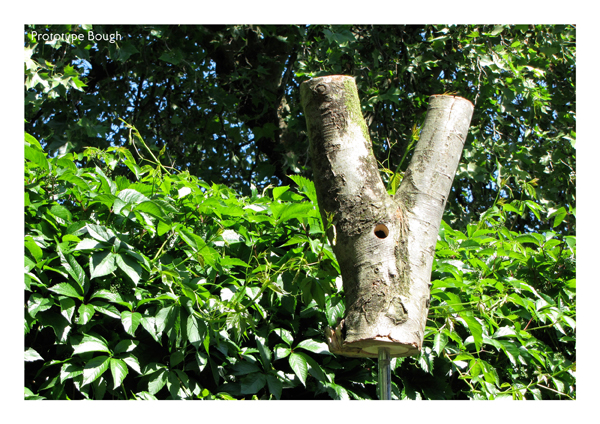Nestworks – ‘assisted readymades’ for urban birds. 51% Studios
2011 Animal Architecture Award Honorable Mention.
2010 saw us tip the balance from more of us living outside the city, to more of us living within one. The means that the outside needs to become the inside – we need to reconcile our fear of the other, of the forest as a territory of unspeakable dangers and dark secrets and encourage cryptoforests to break through the cracks in the paving, bringing with them wildlife, insects and a certain degree of disorder that would otherwise be swept away.
A blue tit needs 1000 caterpillars a day to rear a nest of young, yet many of our favoured urban plantings are exotic aliens producing no food. So when we were asked by the Architecture Foundation to create a legacy project for the 2010 London Festival of Architecture, just as they thought it would be insightful to see how an architect approached the design of birdboxes, we were intrigued to negotiate built-up areas through a bird’s perspective and thus began a series of derives with eminent ornithologist and MBE Peter Holden, to understand how birds navigate and appropriate urban space.
The results were a series of individual ‘assisted readymades’ – immanently implementable ‘Nestworks’ whose ambition was to tip the balance of possibilities available to the urban bird population: providing both shelter and habitat.
Open the windows and listen: something has changed. When the skies fall quiet, volcanic ash clouds grounding planes or the roads silenced by heavy snow, the lull that ensues reveals another more significant absence. It is the acoustic space left by the birds that used to live with us in our cities, before they became so dense and spread so far.
The precipitous fall in the numbers of urban birds is not fully understood. Adjectives normally associated with economic collapse and the free falling statistics of economic depression are appropriate to describe a fall in numbers by 90% in the last 10 years in the case of the House Sparrow: perhaps it is lack of food, perhaps that our hermetically sealed buildings provide no foothold, or maybe it’s that by taking our domestic appliances out into the city (urban hoovers with names like ‘The Glutton’) we are removing not only litter but also habitat, nest linings and insect life.
If we wish to embrace birds within our cities then margins need to be made within the urban fabric for feeding and breeding habitats. This does not mean high-rise balconies of green, nor manicured lawns. Nor does it require dense 1,000 strong concentrations of nesting boxes in architecturally designed walls, sited without consideration of what is known about territories and out of reach of habitat that might provide the staggering quantities of insect life required to support such a concentration of fledgling broods.
The situation has inspired 51% studios to become urban activists formulating an infrastructure of ‘Nestworks’ for urban birds. These Nestworks, rather than megla-maniac visions, are projected gaps, margins in the developers’ visions for the city that need to be left fallow, unmanaged and free for the inhabitation and rearing of birds: Nestworks are ‘assisted readymades’ in the manner of Duchamp, which can be deployed with or without permission, by stealth or by invitation.
Our test bed has been an area of London ambitiously called the ‘Bankside Urban Forest’. Although Bankside and the Southbank are usually synonymous with the cultural triumvirate of the Tate Modern, the Hayward Gallery and the Royal Festival Hall with its fêted concrete brutality, Bankside has a hidden and growing diversity of flora and fauna and airborne wildlife – peregrine falcons hunt from the tower of Tate Modern and Spotted Woodpeckers, Greenfinchs and Wagtails are becoming regular visitors. Here we have installed three prototypes: blocks, boughs and bushes.
We studied behavioural patterns of gregarious birds who favour living in colonies (that’s duplexes or terraces in cityspeak) versus more diffident species who prefer inhabiting individual nests, for example in holes made by woodpeckers (who extraordinarily, given the effort to create them, only use each bough once). As there is a shortage of dead trees in the ‘Urban Forest’ hollowed out boughs were taken from managed woodland nearby and transported to the city as part of a regular food box delivery program to provide homes for Tits and Starlings.
Another material we found conducive to fledglings is woodcrete: made from a woodpulp waste product used to bulk out concrete. Not only is it rat, squirrel and woodpecker proof but also provides thermal comfort, lasts forever and given that it is a recycled material it appealed to our sensibility that privileges kindness to the environment.
We discovered that many of London’s iconic architectural landmarks such as Foster’s Swiss Re, Pelli’s Canary Wharf and Piano’s Shard have been built with this material by concrete manufacturer Lignacite [Lignum = wood in Latin]. Fortuitously their standard hollow block has a perfect cavity size for House Sparrows according to RSPB’s directives.
Robins, Wrens and Blackbirds are usually provided with open-fronted boxes but since their nemesis Jays and Magpies were seen in such abundance during our derives, it was felt that this would be akin to setting up McDonalds for them, and so dense thorny berrying bushes were proposed as a solution for safe nesting, as well as providing an additional source of food.
Nestworks is a site-specific, bespoke, project serving a functional purpose, as habitats for small birds, as well as a playful interface enriching the cityscape and inciting imaginations. A new website (www.urbanbirds.net) employs citizen-science methodologies and will engage individuals in a long-term interagency between committed participants and scientific research objectives. Nestworks is therefore both a public project and a people’s project.


















1 comment
Comments are closed.